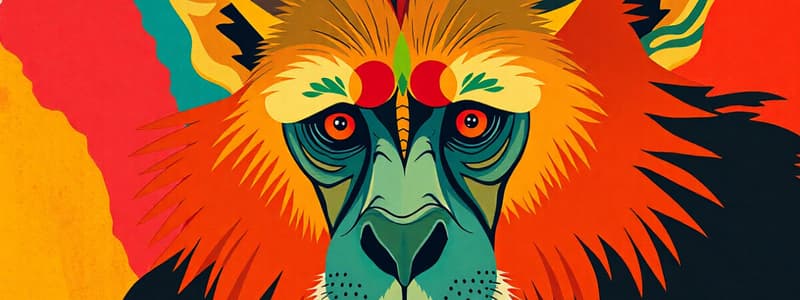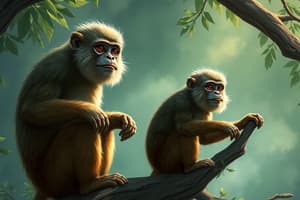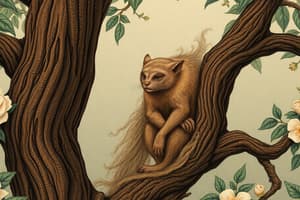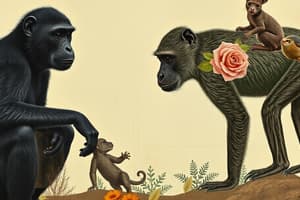Podcast
Questions and Answers
Which characteristic is universal to mammals?
Which characteristic is universal to mammals?
- Grasping fingers
- Fur or hair (correct)
- Learning through play
- Long period of dependence
Which of the following is a shared trait in mammals?
Which of the following is a shared trait in mammals?
- Three-dimensional vision
- Live young (correct)
- Grasping feet
- Relatively flat faces
Primates are mammals with collar bones and what?
Primates are mammals with collar bones and what?
- Mobile wrist joints
- Grasping fingers (correct)
- Short toes
- Long tails
Which physical trait is commonly found in primates?
Which physical trait is commonly found in primates?
What type of environment are arboreal primates adapted to?
What type of environment are arboreal primates adapted to?
Which feature is characteristic of primate hands and feet?
Which feature is characteristic of primate hands and feet?
What is the function of an opposable thumb in primates?
What is the function of an opposable thumb in primates?
Which of the following is a characteristic of primate dentition?
Which of the following is a characteristic of primate dentition?
What type of vision is characteristic of primates?
What type of vision is characteristic of primates?
What is a typical characteristic of primate brains compared to other mammals?
What is a typical characteristic of primate brains compared to other mammals?
What is a common trait regarding primate offspring?
What is a common trait regarding primate offspring?
What is characteristic of primate offspring development?
What is characteristic of primate offspring development?
What is typically observed in primate dependency?
What is typically observed in primate dependency?
What is a key element during primate play?
What is a key element during primate play?
What is a key aspect of social features in primates?
What is a key aspect of social features in primates?
What type of communication is demonstrated when there is meaning without a referent?
What type of communication is demonstrated when there is meaning without a referent?
What is a characteristic of primate communication systems?
What is a characteristic of primate communication systems?
What suborder do lemurs belong to?
What suborder do lemurs belong to?
Which of the following is classified as a haplorrhine?
Which of the following is classified as a haplorrhine?
Which primate group includes monkeys, apes, and humans?
Which primate group includes monkeys, apes, and humans?
Which of the following is a mammal-like trait of Strepsirrhini?
Which of the following is a mammal-like trait of Strepsirrhini?
What primate traits do Strepsirrhini exhibit?
What primate traits do Strepsirrhini exhibit?
What is a common characteristic of lemur social groups?
What is a common characteristic of lemur social groups?
What is a dietary trait often seen in lemurs, lorises, and galagos?
What is a dietary trait often seen in lemurs, lorises, and galagos?
What locomotion style is associated with lemurs, lorises and galagos?
What locomotion style is associated with lemurs, lorises and galagos?
What is a key difference in vision between tarsiers and strepsirrhines?
What is a key difference in vision between tarsiers and strepsirrhines?
What is the typical activity pattern of tarsiers?
What is the typical activity pattern of tarsiers?
What is a distinctive feature of Platyrrhines (New World Monkeys)?
What is a distinctive feature of Platyrrhines (New World Monkeys)?
How many premolars do Platyrrhines typically have?
How many premolars do Platyrrhines typically have?
What is the typical habitat and lifestyle of Platyrrhines?
What is the typical habitat and lifestyle of Platyrrhines?
What is the dental formula of Catarrhines?
What is the dental formula of Catarrhines?
What social structure can be observed in terrestrial catarrhines like baboons?
What social structure can be observed in terrestrial catarrhines like baboons?
Which of the following is a characteristic of hominoid dentition?
Which of the following is a characteristic of hominoid dentition?
Which of the following is a representative of Hylobates?
Which of the following is a representative of Hylobates?
Which locomotion method is characteristic of Hylobates?
Which locomotion method is characteristic of Hylobates?
What term best describes the dietary habits of Orangutans?
What term best describes the dietary habits of Orangutans?
What best describes the locomotion of pongids such as gorillas?
What best describes the locomotion of pongids such as gorillas?
Which behavior is demonstrated by Hominins?
Which behavior is demonstrated by Hominins?
Which of these is a shared trait in mammals?
Which of these is a shared trait in mammals?
Which of the following locomotion styles is associated with primates?
Which of the following locomotion styles is associated with primates?
Forward-facing eyes and stereoscopic vision allows primates to have what?
Forward-facing eyes and stereoscopic vision allows primates to have what?
What is a typical characteristic of primate offspring?
What is a typical characteristic of primate offspring?
To what does referential communication refer in primates?
To what does referential communication refer in primates?
Flashcards
Animals
Animals
Organisms able to move on their own.
Chordates
Chordates
Animals with a backbone.
Mammals
Mammals
Chordates with fur or hair and milk glands.
Primates
Primates
Signup and view all the flashcards
Hominids
Hominids
Signup and view all the flashcards
Homo
Homo
Signup and view all the flashcards
Homo Sapiens
Homo Sapiens
Signup and view all the flashcards
Primate Traits
Primate Traits
Signup and view all the flashcards
Arboreal
Arboreal
Signup and view all the flashcards
Prehensile Hands and Feet
Prehensile Hands and Feet
Signup and view all the flashcards
Opposable Thumb
Opposable Thumb
Signup and view all the flashcards
Omnivorous Diet
Omnivorous Diet
Signup and view all the flashcards
Stereoscopic Vision
Stereoscopic Vision
Signup and view all the flashcards
Strepsirrhini
Strepsirrhini
Signup and view all the flashcards
Haplorrhini
Haplorrhini
Signup and view all the flashcards
Tarsiers
Tarsiers
Signup and view all the flashcards
Platyrrhines
Platyrrhines
Signup and view all the flashcards
Catarrhini
Catarrhini
Signup and view all the flashcards
Hominoidea
Hominoidea
Signup and view all the flashcards
Longer Snouts
Longer Snouts
Signup and view all the flashcards
Rhinarium
Rhinarium
Signup and view all the flashcards
Primate traits
Primate traits
Signup and view all the flashcards
Females dominate social group
Females dominate social group
Signup and view all the flashcards
Vegetarian diet; insects
Vegetarian diet; insects
Signup and view all the flashcards
Rounded braincases
Rounded braincases
Signup and view all the flashcards
More fully formed placenta
More fully formed placenta
Signup and view all the flashcards
Highly dexterous hands
Highly dexterous hands
Signup and view all the flashcards
Hylobates
Hylobates
Signup and view all the flashcards
Pongids
Pongids
Signup and view all the flashcards
Hominins
Hominins
Signup and view all the flashcards
Hominoids: Hylobates
Hominoids: Hylobates
Signup and view all the flashcards
Little sexual dimorphism
Little sexual dimorphism
Signup and view all the flashcards
Frugivores
Frugivores
Signup and view all the flashcards
Socially solitary
Socially solitary
Signup and view all the flashcards
Quadrupeds
Quadrupeds
Signup and view all the flashcards
Knuckle-walkers
Knuckle-walkers
Signup and view all the flashcards
Flexible membership
Flexible membership
Signup and view all the flashcards
Small body size adaptations
Small body size adaptations
Signup and view all the flashcards
Nocturnal Adaptation
Nocturnal Adaptation
Signup and view all the flashcards
Frugivore Adaptation
Frugivore Adaptation
Signup and view all the flashcards
Fast moving in trees
Fast moving in trees
Signup and view all the flashcards
Large body adaptations
Large body adaptations
Signup and view all the flashcards
Active during Day and Live in large groups
Active during Day and Live in large groups
Signup and view all the flashcards
Increase brain size relative to body size
Increase brain size relative to body size
Signup and view all the flashcards
Study Notes
Shared Traits in Mammals
- Live young, produce mother's milk, have a long period of dependence, and learn through play.
Primate Physical Traits
- Possess a unique combination of traits
- Arboreal adaptations for tree-dwelling
- Prehensile hands and feet, including an opposable thumb
- Flexible arm movement
- Have specific upper and lower limb bones
Shared Physical Traits
- Have an omnivorous diet, with specialized teeth
- Forward-facing eyes allow for stereoscopic, color vision
- Larger brains
Reproduction
- Typically have one to few offspring
- Infants are born helpless
- Take a relatively long time to reach sexual maturity
Dependency and Play
- Exhibit long dependency periods
- Have a strong mother-infant bond
- Develop physical and social skills through play
- Learning occurs through imitation, independent exploration, and deliberate teaching.
Social Features: Communication
- Use referential communication, where sounds are associated with objects or events
- *Semantic communication is a feature
- Symbolic communication involves arbitrary meanings
- Primate communication operates as a closed system
Primate Classification
- Clades are approached to classify primates
- Derived and ancestral traits are compared in classification
- Refer to Etting 2023 Chapter 5 for discussion of traits.
Strepsirrhini Traits
- Mammal-like characteristics such as longer snouts, a rhinarium, olfactory emphasis, and mobile ears
- Grasping hands and stereoscopic vision are also primate traits
Strepsirrhini Examples
- Strepsirrhines include lemurs, lorises, and galagos
- Females typically dominate social groups
- Not sexually dimorphic
- Diet consists of vegetarian food and insects
- Quadrupeds that use vertical clinging and leaping
Haplorrhini Traits
- Have a rounded braincase
- Rely on better vision and lack a rhinarium (have a dry nose)
- Have reduced, non-mobile ears
- Have relatively small, flat faces
- More fully formed placenta
- Highly dexterous hands
Tarsiers Traits
- Nocturnal and arboreal
- Insectivores
- Haplorrhines
- Have eyes set in bony orbits, lacking a tapetum lucidum (no eyeshine at night)
- Are vertical clinger-leapers, similar to lemurs.
Platyrrhines Traits
- New World Monkeys, defined by three premolars
- Some have a prehensile tail
- Arboreal lifestyle
- Dentition of 2.1.3.3/2.1.3.3
- This group includes marmosets, tamarins, and cebids such as capuchins
Catarrhines Traits
- Includes cercopithecoids
- Arboreal colobine monkeys
- Terrestrial baboons
- 2.1.2.3 dental formula in both upper and lower jaws
- Variable group size
- Male-dominated social structures
- Have few offspring
- Female troops
- Exhibit sexual dimorphism
Hominoids - Apes and Humans
- Includes Hylobates, Pongids, and Hominins
- Larger brains and greater flexibility
- Have longer limbs
- Possess a short, broad trunk and lack a tail
Hominoid Dentition
- Teeth are flat and rounded
- Have a Y-5 pattern
- Canine diastema
Hominoids - Hylobates
- Are brachiators
- Small body size and weight
- Prefer frugivores diets
- Live in small family units
- Display little sexual dimorphism
Pongids - Orangutans
- Arboreal
- Frugivores
- Display sexual dimorphism
- Socially solitary
- Unknown Diet and possible Predation?
Pongids - Gorillas
- Quadrupedal and are knuckle walkers
- Tend to eat and sleep in trees
- Tend to have a dominant male as a protector
- Flexible membership
Pongids - Bonobos and Chimpanzees
- Bonobos live in stable, female-centered groups
- Chimpanzees live in fluid groups
- Both are Quadrupedal and bipedal
- Frugivore based Diet, with some meat
- Highly social, in large groups
Primate Adaptations: Body Size and Lifestyle
- Small body size primates tend to be Nocturnal, Arboreal, and Frugivore
- fast moving in trees, low weight
- Fruit sugars provide high energy
- Easier to move around at night
- Larger body size primates is Diurnal, Terrestrial, and Vegetarian
- Slow moving because of where primates live, large body primates are easier to view
- Vegetation is very poor so primates have large guts for digestive purposes
- Active during day, and live in large groups for protection
General Primate Adaptations
- Exhibit an increased brain size relative to body size.
- Frugivores tend to have larger brains
- They remember when to collect the fruit, where the fruit is located
- Experience variable group size depending on the location
- Use Safety precautions
- Have smaller numbers when feeding at night
- Have larger number when feeling in the day
Hominins - Homo Sapiens
- Capable of bipedalism
- Have a dish-shaped pelvis
- Straight lower limbs
- Feet are not prehensile
- Hands are dexterous
- No large teeth or claws
Defining Traits of Homo sapiens
- Large, complex brain with a large cerebral cortex which helps thinking and helps with spoken language and have lowered larynx
- Capable of Dentition
- Reflect an omnivorous diet
- Similar incisors and canines which lack spaces between teeth
Hominins - Learning and Tool Use
- Learn through culture
- Use tools (Greater apes)?
- Chimpanzees use termite sticks
- Demonstrate planning and make tools
- Able to Crack seeds open with two rocks
Models for Understanding Hominin Behavior
- Considers homologous vs. analogous traits
- Uses the behavior of living primates as a model
- Employs ethnographic analogy, but recognizes its limitations
- All cultural groups have qualities, and this is not always reflective of the universal pattern
Studying That Suits You
Use AI to generate personalized quizzes and flashcards to suit your learning preferences.




